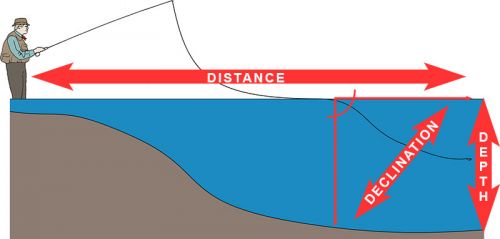Jason Borger | Tuesday, 24 January 2017
This is my final weekly FP here at SL. I thought about some clever ways to end my stint here, but they all felt like I was trying to be too clever. So, I decided to just post another bit about fishing and leave it at that. I hope that you find this last FP to be useful on your own fly fishing journey. I call it "Going Deep."
When it comes to going deep, there are a myriad of equipment choices that confront the fly fisher. Automatically assuming that more weight is the key to success might be a mistake. You must tune your equipment to your presentation techniques in order to go deep in the most efficient and effective manner.
There are two basic questions that you should ask yourself when trying to go deep: 1) Where do the fly and line need to be? 2) What does the fly need to be doing after it gets there?
When it comes to answering the “where,” think in 3-D: Depth, Distance, and Declination. How deep do you need the fly to get? How far do you need to cast to reach the fish? What needs to be the relative angle of the line and leader to the surface? Answering the “what” is fairly simple: How will the fly be worked?
In order to solidify the relationship between the questions, here are two salmon fishing situations (Pacific salmon, that is), each of which requires going deep.
Situation one: Alaska. Slinging and swinging big streamers to kings holding in a 6 to 8-foot-deep run. Viewed in 3-D, the fly needs to intercept the salmon on their level and stay there. Casting will be in the 30- to 50-foot range. The end of the line and the leader need to go deep, but at the same time, you may need to mend. The fly will be drifting and then swinging, and there may be an active retrieve near the end of the swing.
One answer is to start with a sink-tip line. The sinking end of the line gets the fly down and holds it there, while the floating portion can be mended. A similar option is to use a floating line with loop-on lead-core. This can helpful if the situation changes to that of sight-fishing, or if the salmon are bunched up and foul-hooking is an issue (remove the lead-core and use the leader outlined in the next situation).
To match the line, you will need a leader that will go down with the sink-tip, and help control the fly. Perhaps 3 feet of .024”, 1 foot of .017”, 1 foot to 18 inches of .013”, and 6 to 8 inches of .011” (0X). A split shot and/or a piece of putty above the last knot will help keep the leader deep.
Situation two: Wisconsin, USA. Sight-fishing with bunny leeches to individual kings or cohos holding in two to four feet of water. Viewed in 3-D, the fly needs to tumble and/or swim just above the bottom. Casting is fairly up-close-and-personal, typically not much more than 30 feet, and sometimes much less. The leader needs to allow the fly to get down fast, and presentation accuracy is important. Depending on how each fish responds, it may be necessary to swim the fly at the right time, but long ranges of motion will not be necessary.
One solution is to begin with a floating line, perhaps designed with a “streamer” or “nymph” taper for better delivery of a water-logged fly at short to moderate ranges. A fully floating line works well, since the fly does not need to get very deep for very long. A floater can also be mended quickly.
To go with the line, you need a leader that can allow the fly to get to depth quickly, and not drag the line into the process, so to speak. Indeed, the fly may end up being delivered like a big nymph—with the more vertically oriented Tuck Cast. Something like 4 feet of .026”, 2 feet of .018”, 1 foot of .013”, and 8inches to 1 foot of .011” (0X) can do it. A split shot may go above the 1X juncture knot or the fly, with the rest of the weight in the fly itself. The fly and leader get down quickly (especially with a Tuck Cast), the line can be manipulated/mended easily, and small amounts of movement can be added to the fly on command.
When it is time to get a fly down, don’t just slap on the weight and hope for the best. Ask yourself where (in 3-D) and what, and then tune your equipment for going deep.